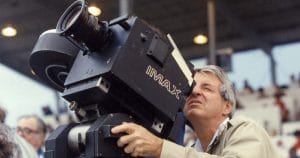A film director, producer, writer and cinematographer, Ferguson was obsessed with image quality. The usual 35mm film in movie cameras just wasn’t good enough no matter what brand the film was. At Expo 67 in Montreal, Que., Canada, his film Man and the Polar Regions used a multi-projector, multi-screen technique (similar to the 1952 multi-projector Cinerama system), but it proved very difficult to keep the projectors in sync (similar to the 1952 multi-projector Cinerama system). Ferguson co-founded (with three friends from high school) a new company, Multiscreen Corp., to fix the problem. They decided to use the already-available 70mm film, but with a twist: they turned it on its side so that the frame wasn’t a mere 70mm wide, but rather 70mm tall, allowing for an even wider frame. The result was nearly 10x the size of a regular 35mm frame. With that innovation, they didn’t need multiple projectors for a huge and beautiful screen image, they just needed one — one huge projector shining on a gigantic (18×24 m, or 59×79 ft) screen. That provided “a revolutionary immersive theater experience,” gushed the Hollywood Reporter. The next question was, what to call it? “We were sitting at lunch one day in a Hungarian restaurant in Montreal and we worked out a name on a placemat on which we wrote all the possible names we could think of,” Ferguson remembered later. “We kept working with the idea of maximum image. We turned it around and came up with IMAX.” He served as the company’s president for its first 20 years.


The new system was ready to go by Expo 70 in Osaka, Japan: Tiger Child, directed by fellow Canadian Donald Brittain, was the first film created with the IMAX system. But Ferguson had loftier ideas: he got NASA to take his camera into space — repeatedly. The documentary Hail Columbia! was released in 1982, followed by The Dream is Alive in 1985. The latter inspired a U.S. Air Force officer to apply to the astronaut program: Susan Helms not only went into space, she appears in another Ferguson-produced IMAX documentary, 2002’s Space Station 3D. Ferguson was also the executive producer of the 2010 documentary, Hubble 3D. Ivan Graeme Ferguson was awarded the Order of Canada in 1992, and died May 8 at his Ontario home, from cancer — just 8 weeks after his wife, Phyllis, died. He was 91.
